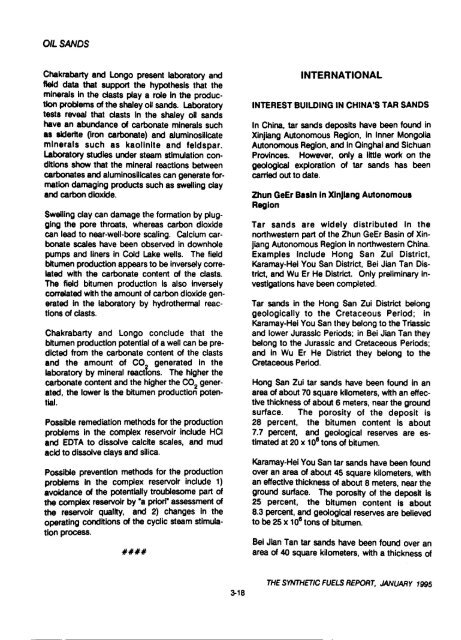Ikelic - Alliance Digital Repository
Ikelic - Alliance Digital Repository
Ikelic - Alliance Digital Repository
You also want an ePaper? Increase the reach of your titles
YUMPU automatically turns print PDFs into web optimized ePapers that Google loves.
OIL SANDS<br />
Chakrabarty and Longo present laboratory and<br />
field data that support the hypothesis that the<br />
minerals in the ciasts play a role in the produc<br />
tion problems of the shaley oil sands. Laboratory<br />
tests reveal that ciasts in the shaley oil sands<br />
have an abundance of carbonate minerals such<br />
as sWerite (iron carbonate) and aluminosilicate<br />
minerals such as kaolinite and feldspar.<br />
Laboratory<br />
studies under steam stimulation con<br />
ditions show that the mineral reactions between<br />
carbonates and aluminosilicates can generate for<br />
mation damaging products such as swelling clay<br />
and carbon dioxide.<br />
Swelling clay can damage the formation by plug<br />
ging the pore throats, whereas carbon dioxide<br />
can lead to near-well-bore scaling. Calcium car<br />
bonate scales have been observed in downhole<br />
pumps and liners in Cold Lake wells. The field<br />
bitumen production appears to be inversely corre<br />
lated with the carbonate content of the ciasts.<br />
The field bitumen production is also inversely<br />
correlated with the amount of carbon dioxide gen<br />
erated in the laboratory by<br />
tions of ciasts.<br />
Chakrabarty<br />
hydrothermal reac<br />
and Longo conclude that the<br />
bitumen production potential of a well can be pre<br />
dicted from the carbonate content of the ciasts<br />
and the amount of CO, generated in the<br />
laboratory by<br />
mineral reactions. The higher the<br />
carbonate content and the higher the C02 gener<br />
ated, the lower is the bitumen production poten<br />
tial.<br />
Possible remediation methods for the production<br />
problems in the complex reservoir include HCI<br />
and EDTA to dissolve calcite scales, and mud<br />
acid to dissolve clays and silica.<br />
Possible prevention methods for the production<br />
problems in the complex reservoir include 1)<br />
avoidance of the potentially troublesome part of<br />
priori"<br />
the complex reservoir by "a assessment of<br />
the reservoir quality, and 2) changes in the<br />
operating conditions of the cyclic steam stimula<br />
tion process.<br />
####<br />
3-18<br />
INTERNATIONAL<br />
INTEREST BUILDING IN CHINA'S TAR SANDS<br />
In China, tar sands deposits have been found in<br />
Xinjiang Autonomous Region, in Inner Mongolia<br />
Autonomous Region, and in Qinghai and Sichuan<br />
Provinces. However, only a little work on the<br />
geological exploration of tar sands has been<br />
carried out to date.<br />
Zhun GeEr Basin in Xinjiang Autonomous<br />
Region<br />
Tar sands are widely distributed in the<br />
northwestern part of the Zhun GeEr Basin of Xin<br />
jiang<br />
Examples include Hong San Zui District,<br />
Karamay-Hei You San District, Bei Jian Tan Dis<br />
Autonomous Region in northwestern China.<br />
trict, and Wu Er He District. Only preliminary in<br />
vestigations have been completed.<br />
Tar sands in the Hong San Zui District belong<br />
geologically to the Cretaceous Period; in<br />
Karamay-Hei You San they belong to the Triassic<br />
and lower Jurassic Periods; in Bei Jian Tan they<br />
belong to the Jurassic and Cretaceous Periods;<br />
and in Wu Er He District they belong to the<br />
Cretaceous Period.<br />
Hong San Zui tar sands have been found in an<br />
area of about 70 square kilometers, with an effec<br />
tive thickness of about 6 meters, near the ground<br />
surface. The porosity of the deposit is<br />
28 percent, the bitumen content is about<br />
7.7 percent, and geological reserves are es<br />
timated at 20 x 106<br />
tons of bitumen.<br />
Karamay-Hei You San tar sands have been found<br />
over an area of about 45 square kilometers, with<br />
an effective thickness of about 8 meters, near the<br />
ground surface. The porosity of the deposit is<br />
25 percent, the bitumen content is about<br />
8.3 percent, and geological reserves are believed<br />
to be 25 x 106<br />
tons of bitumen.<br />
Bei Jian Tan tar sands have been found over an<br />
area of 40 square kilometers, with a thickness of<br />
THE SYNTHETIC FUELS REPORT, JANUARY 1995















![pace SrntfletIc fne]its report - Alliance Digital Repository](https://img.yumpu.com/10493335/1/190x245/pace-srntfletic-fneits-report-alliance-digital-repository.jpg?quality=85)
